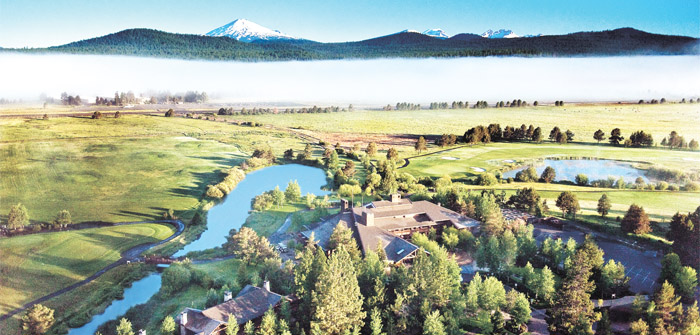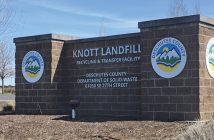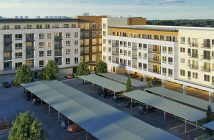(Above Photo | Photo Courtesy of Sunriver Nature Center & SROA)
On the shores of the Deschutes River 15 miles south of Bend, tucked away in the ponderosa pines, is Sunriver. This gem of Central Oregon offers world-class golfing, biking, kayaking, boating, tennis, pickleball, fly fishing, skiing and general relaxation that makes it the destination of choice for travelers from around the world. While it’s now known for its fine dining, championship golf courses and luxurious lodging, its beginnings were much more humble.
Nearly 7,000 years ago lava flows dammed the Deschutes River at Benham Falls, backing up a lake that covered much of what is now Sunriver. When the river finally broke through and the lake receded, a lush meadow surrounded by thick forests was left behind. The area was a natural gathering spot for Native Americans based on numerous artifacts found in the area dating back thousands of years.
During the winter of 1843, explorer John C. Fremont and guide Kit Carson ventured into the area on their
way south.
In 1855, the Army Corps of Topographical Engineers surveyed a route through the area for a railroad between California and the Columbia River. This party was led by Robert Stockton Williamson and Henry Larcom Abbot. Among the group were geologists, botanists, physicians, naturalists, engineers and soldiers.
In the late 1800s cattlemen began to drive their herds to the area to graze in the lush meadowlands. The Vandeverts were among the first homesteaders in the area, their ranch was just south of current day Sunriver. Their children attended the Meadow School, which was located very close to the present Sunriver Lodge. During the next 50 years the area was used by the cattlemen, trappers and a few hardy pioneers who settled in the area with their families.
In the midst of World War II, the U.S. Government wanted to establish a combat engineer training facility on a site that resembled the climate and topography of Northern Europe.
Robert Sawyer, publisher of the Bend Bulletin, persuaded the Army Corps of Engineers to build the Army training post 18 miles south of town on the Shonquist Ranch, the site of modern day Sunriver. It was named Camp Abbot. Local folks were surprised the Army found the almost 9,700 acres straddling the Deschutes River a perfect place to train soldiers.
Those who helped build the camp were remembered as saying what a miserable job it was. Construction began in December 1942 and continued through the worst winter in 30 years, with more than 60 inches of snow through March 1943. Camp Abbot officially opened the following year. Training included basic combat skills, marksmanship, field maneuvers, bridge building and demolition.
The camp was a self-contained city complete with water and sewer systems and housing up to 10,000 people at a time. Many of its structures were built from the surrounding timber and stone, most notably the impressive officer’s club with its high ceiling, large stone fireplace and balcony overlooking the main floor. This structure still stands today and is called The Great Hall. It was renovated in 1993 but maintains the feel of the original structure.
Just like today, vehicles arriving at Camp Abbot passed over a railroad bridge. The first thing on their right was a medical demonstration area (now Antelope and Bobcat Lanes), with the post stockade just beyond. The gas chamber, where troops trained in chemical warfare defense, was near Hare and Jay Lanes.
The post included a 411-bed hospital complex that stretched from the current business park to near Parkland and East Park Lanes. There were numerous training fields, barracks, dining facilities and warehouses. There was a post motor pool, coal storage area and sewage treatment plant. (Sunriver Owners Association still uses one of the sedimentary tanks, now called a round house, for maintenance work and storage.)
Out in the meadow, two rifle ranges (stretching from today’s airport runway to River Road) and two machine gun ranges echoed with the sound of rapid fire. Beyond them was the anti-tank range.
More than 90,000 combat engineers were trained at Camp Abbot before it abruptly closed in June 1944.
In the years following WWII some of the former Camp Abbot land was returned to the U.S. Forest Service, but 5,500 acres were sold as private land. The property changed hands multiple times until 1965 when John Gray and Donald McCallum obtained the land for development, forming
Sunriver Properties.
The Sunriver Lodge was constructed, as were the stables, Meadows Golf Course and an airstrip. Additionally, large areas for residential home sites were plotted. The bike paths were created, although were originally designed for use by electric golf carts as an alternative means of transportation. Lot sales and home construction began in 1968.
By the time John Gray sold the resort property to the Connecticut Mutual Life Insurance Company in 1974, some 600 private homes and condominiums had been built. During a severe economic recession in the 1970s, 2,200 of Sunriver’s original 5,500 acres were sold back to the U.S. Forest Service. By 1979 the number of privately owned homes had doubled to 1,200. In 1993 Sunriver Resort Limited Partnership purchased Sunriver Resort and began a capital improvement campaign that continues to this day.
Today there are more than 4,000 homes and condominiums, many of which are second homes owned by people who live up and down the West Coast, across the country and around the world. Many are available as vacation rentals and these, combined with the Resort’s overnight lodging facilities, host as many as 15,000 visitors a day in the heat of the summer and during winter holidays.
Sunriver has a long and rich history dating back hundreds if not thousands of years. From its beginnings as a trapper’s rendezvous point to a World War II training area, modern day Sunriver has become a paradise for all to enjoy.





